Saint Catherine Street
Saint Catherine Street (French: rue Sainte-Catherine) (11.2 km or 7.0 mi) is the primary commercial artery of Downtown Montreal, Quebec, Canada. It crosses the central business district from west to east, beginning at the corner of Claremont Avenue and de Maisonneuve Boulevard in the city of Westmount, traversing the borough of Ville-Marie, and ending on Notre-Dame Street just east of Viau Street in the borough of Mercier–Hochelaga-Maisonneuve.
.jpg) Sainte-Catherine Street, Downtown Montreal | |
| Native name | French: rue Sainte-Catherine |
|---|---|
| Length | 11.2 km (7.0 mi) |
| Location | Between Notre-Dame Street and Claremont Avenue |

The street runs parallel to the largest segments of Montreal's underground city. The series of interconnected office tower basements and shopping complexes that make up this main thoroughfare lie immediately north of the street.
Educational institutions located on or near the street include Concordia University, McGill University, Université du Québec à Montréal, Dawson College and LaSalle College.
History
In its early years Saint-Catherine Street was known as Saint-Genevieve or Saint-Gabriel; according to Paul-André Linteau, during that time it was commonplace for street names to change frequently.[1] It is not known exactly where the name, Saint Catherine Street, originated, but there are three prevalent theories on how it came about. According to the first theory which has been put forward by Cléphas Saint-Aubin the name of the street was meant to honor Catherine de Bourbonnais, the suspected illegitimate child of King Louis XV. Another theory, which is probably the easiest to accept is that the street was named for the Catholic saint Catherine of Alexandria . The final theory is that the street was named by Jacques Viger for one of his daughters-in-law, Catherine Elizabeth[1].
It is not known exactly when Saint Catherine Street was built as it wasn’t part of any city plan; it just happened to be one of the streets that many people frequented. The street began to grow in 1736, in the Saint-Laurent Borough on either side of Saint Laurent Boulevard, which is located close to the centre of Montreal and runs from north to south. Saint Catherine runs from east to west.
In the 18thcentury Montreal had no municipal council all administrative issues pertaining to construction and maintenance of roads fell to justices of the peace and the Roads Act of 1796 allowed the justices to oversee approval and denial of road construction and making sure that the roads were paid for. Landowners and farmers were often pressured to agree to and pay for the construction of streets. Road inspectors like Montreal’s first mayor Jacques Viger were appointed and their responsibilities were to make sure that roads like Saint-Catherine Street were draining properly, they roads were level, aligned properly and were adequately paved[1].
Construction and Development[1]
Because Saint Catherine Street wasn’t planned, it grew in sections at a time during different periods, as confirmed by historian Alan Stewart[1]. There were 4 distinct stages of development; the first section which ran from Saint-Alexandre Street to Sanguinet Road grew from 1758 to 1788, the street was 24 feet wide at this time.
The second stage of development started in 1820 and ended in 1860, and during this time construction was more concentrated in the western part of the street though there was also some construction in eastern part of the street, running past Sanguinet Road to Panet Road. The western part of the street grew from Sainte-Alexandre Street to McGill College Avenue in 1840. In the 1850s it grew from McGill College Avenue past De la Montagne Road and Guy Street until it reached Atwater Avenue.
The third stage took up from where the second stage left off in 1860 and lasted until 1890. In 1872, Sainte-Catherine advanced west to Greene Avenue, then moved past Victoria Avenue in the 1880s. In the east the street grew to De Lorimier Avenue and Fullum Road by 1863 and in the next couple of years it stretched to Du Havre Road.
The 4thand final stage of development occurred from 1890 and ended in 1910. By 1890 there had been sections that had been built in the neighborhoods of Hochelaga and Maisonneuve. In 1910 the street stretched to Vimont street.
In the 1950s, in order to complete this monster of a street, “short hooked segments” had to be added on either end of the street to finish the street off, in the east it hooked into Notre-Dame Street and in the west, it hooked into De Maisonneauve Boulevard. The street is now 11.2 km long and is considered the backbone of Downtown Montreal.
Growing Popularity
By the end of the 19th Century Saint-Catherine had garnered some notoriety as being the entertainment hub of Montreal.[2] By 1850, horse-drawn streetcars were starting to be seen on the street with growing frequency and in 1864 the first electric powered tramway provided by the Montreal City Passenger Railway was introduced on Saint-Catherine Street[1]. This allowed workers to get to and from their jobs in other parts of the city, as well as transporting many housewives to the many department stores that had started to appear on Sainte-Catherine in the 1930s like Morgan’s, Eaton’s, Simpson’s, Ogilvy’s and Dupuis as well as jewelry stores like Birks.[3] In 1890, there was also evening entertainment with both English and French theatres and the Academy of Music lining the street near the intersection with Victoria Avenue[2]. This helped usher in a new way of city life that evolved into how Montrealers now live.
Retailers
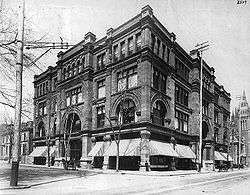
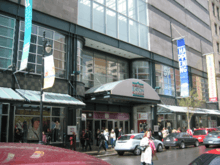

St. Catherine Street has been home to many of Montreal's prominent department stores, including such former retailers as Eaton's, Morgan's, Simpson's and Dupuis Frères. Today, the Henry Morgan Building is home to Hudson's Bay Company, which acquired Morgan's in 1960. The Simpson's building is now shared by the Simons department store and a multiplex cinema, while Eaton's was converted to the Complexe Les Ailes. Dupuis Frères, located further east at St. Catherine and St. Hubert, is now a shopping mall and office complex.
The Ogilvy's department store remains a fixture on St. Catherine Street, although it is now a collection of boutiques rather than a single store.
Other major retailers along the street including an Apple Store, AVEDA Experience Centre, Indigo Books and Music, Archambault, La Senza, Best Buy, Roots, Adidas, Puma, Guess, Parasuco, Zara, Mango and an H&M flagship store at the corner of Peel and St. Catherine. Additionally, many of Montreal's most prominent shopping complexes, including the Eaton Centre, Complexe Les Ailes, Place Montreal Trust, Promenades Cathédrale, les Cours Mont-Royal (a high fashion shopping mall), the Complexe Desjardins, Place Dupuis, Place Alexis Nihon, the Faubourg Sainte-Catherine and Westmount Square are all located along the street.
The Montreal Forum, once home to the Montreal Canadiens, is also located on St. Catherine Street at Atwater Street. It has since been turned into a shopping and movie theatre complex called the Pepsi Forum. Due to the Forum's presence on this street, St. Catherine was used as the parade route whenever the Canadiens won the Stanley Cup. This was once referred to as "the usual route" by Mayor Jean Drapeau, during the Canadiens' dynasties of the mid-century, when a win would occur quite frequently.
The segment in the district of Hochelaga-Maisonneuve is also an important commercial area in that neighbourhood.
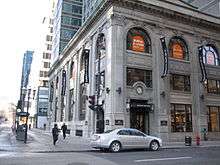 Banana Republic store at the corner of McGill College Avenue.
Banana Republic store at the corner of McGill College Avenue. Place Montreal Trust shopping centre.
Place Montreal Trust shopping centre. H&M store at the corner of Peel Street.
H&M store at the corner of Peel Street.- Ogilvy's department store in Montreal
 Montreal's Apple Store.
Montreal's Apple Store.
Street closures
For one weekend in July every year, Saint Catherine Street hosts Canada's largest open-air sidewalk sale. 2 km (1 mi) of the street between Jeanne-Mance Street and St. Mark is closed to traffic, and vendors from nearby shopping centers bring out their sale merchandise. There is also live entertainment along the street. It is estimated that over 300,000 people visit the downtown during this event.[4]
Transit
The Green line of the Montreal Metro was built to serve Sainte-Catherine Street; however, to avoid disrupting traffic on the street, it was built one block to the north, under parts of Burnside Place, which once joined together, later became de Maisonneuve Boulevard. Bus service is provided by the STM's 15 Sainte-Catherine and 34 Sainte-Catherine which both operate 7 days a week.[5]
Culture

Montreal's Place des Arts, the city's primary concert venue, is located on Saint Catherine Jeanne-Mance and Saint-Urbain streets, in the city's Quartier des Spectacles entertainment district. The street was once home to many now-abandoned cinemas such as the Loews, Palace, Capitol, Cinéma de Paris, York, Ouimetoscope and the Seville Theatre as well as the demolished Montreal Spectrum music venue.
Places of worship
The street is also home to Christ Church Cathedral[6], the only church in Canada that sits atop a shopping mall, Promenades Cathédrale; another important church, Saint James United Church[7], has recently had its concealing façade of commercial buildings removed. Other churches on the street include St. James the Apostle Anglican Church.
Gay Village
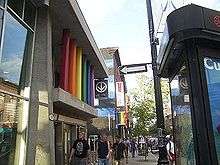
Montreal's Gay Village (French: Le Village gai) extends along Sainte-Catherine Street in the east end of downtown, between Saint-Hubert and Papineau. Beaudry Metro station, on the Green Line, provides the most convenient access to the Village and sports a permanent rainbow decoration on its façade.
For most of the summer, from mid-May till mid-September, Sainte-Catherine Street is completely closed to vehicular traffic through the Gay Village, making it one large pedestrian area, allowing all the stores to sell outside and all the restaurants and bars to serve on large, open-air terrasses.
Summer is also punctuated with special events and festivals such as the art festival FIMA, Festival International Montréal en arts, Pride Celebrations and Divers/Cité.
Night life
The strip clubs which made their home on Saint Catherine have now declined in number, though a few prominent clubs, such as Super Contact, remain.
Gallery
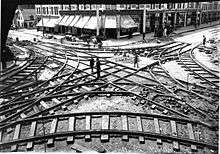 Sainte-Catherine in 1893
Sainte-Catherine in 1893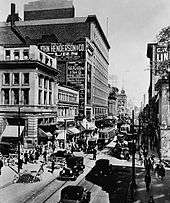 In 1930
In 1930 In 1943 at Montagne
In 1943 at Montagne- Until October 2014, a Chapters bookstore was located inside the Castle Building on the corner of Stanley St.
References
- 1946-, Linteau, Paul-André (2010). Sainte-Catherine street : at the heart of Montréal life. Lemery, Claude-Sylvie., Létourneau-Guillon, Geneviève., Pointe-à-Callière, musée d'archéologie et d'histoire de Montréal. Montréal: Pointe-à-Callière, Montréal Museum of Archaeology ans History. ISBN 9782761927529. OCLC 706909723.CS1 maint: numeric names: authors list (link)
- Cooper, John Irwin (1942). Montreal, the Story of Three Hundred Years. Montreal: L'Imprimerie de Lamirande.
- Paul-Andre., Linteau (2013). The history of Montreal : the story of a great North American city. Montreal: Baraka Books. ISBN 9781926824802. OCLC 1053883884.
- La grande braderie estivale (in French) Archived 2007-07-16 at the Wayback Machine
- "Visitors". Société de transport de Montréal. Retrieved 2020-01-30.
- "Christ Church Cathedral". Christ Church Cathedral. Retrieved 2020-01-30.
- "Home - Square St. James". stjamesmontreal.ca. Retrieved 2020-01-30.
| Wikimedia Commons has media related to Saint Catherine Street, Montreal. |